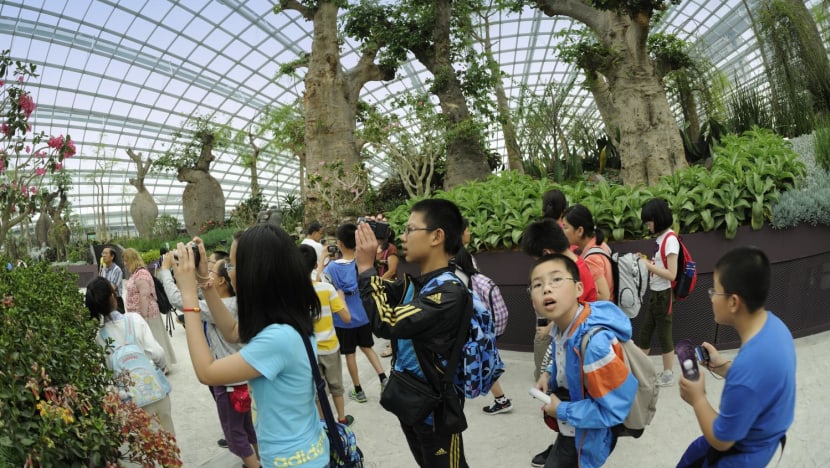IN FOCUS: From reclaimed land to glass domes and towering metal trees - how Gardens by the Bay has blossomed
A decade after Gardens by the Bay opened, CNA speaks to members of the team who have been there since the beginning about how it all began.

Visitors enjoying the baobabs in the Flower Dome at Gardens by the Bay in its opening week in June 2012. (Photo: Gardens by the Bay)
SINGAPORE: The day before Gardens by the Bay officially opened to the public in June 2012, then-assistant director of development Ong Chui Leng and her team waited with bated breath to see how people would respond to the new attraction.
“We were all looking at each other. We said: ‘This time there’s no closing already,’” she told CNA.
When Gardens by the Bay finally opened its doors, the team was surprised by the overwhelming reception. The scale of the gardens “really blew people away”, Ms Ong said.
The S$1 billion attraction went on to receive 2 million visitors in the first year after it opened. This doubled to 4 million the following year.
Ten years on, the gardens have seen a total of 85 million visitors, with both locals and tourists enjoying its lush greenery and giant glass domes.

HOW IT ALL BEGAN
When the idea of a garden in the Marina Bay area was first broached in 2005, Singapore’s image as a garden city was already “quite established”, said Ms Ong.
“At that time, Dr Tan had the idea of bringing in different parts of the world in terms of horticulture," she said, referring to Dr Kiat W Tan, the founding CEO of Gardens by the Bay.
"The tagline then was that we would bring the world to Singapore, and in so doing, we present Singapore to the world.”
Gardens by the Bay was one component of a bold vision for Marina Bay, adding to the Esplanade, the Singapore Flyer and the Marina Bay Sands integrated resort.
The area picked out for the new garden was the site of the then Marina City Park. Dr Tan wanted to include a conservatory and to bring in plants from temperate countries. The team pitched it as a 101-hectare garden.
The idea was to take that space and allow people to have free access to the entire waterfront, said Ms Ong.
But there were some doubts about how the public would take to such an offering.
“We were even worried because at the time we were thinking, would people really warm to plants? Do we need to bring in animals? We were even talking to the zoo – maybe we should bring some orangutans in.”




Realising the full vision of what Gardens by the Bay would be was not totally straightforward. That was because at one point it was not clear if there would be enough funding to build both the Cloud Forest and Flower Dome, said Ms Ong, who is currently project director of the Bay East Project Office.
The Cloud Forest and Flower Dome are the huge conservatories that form a major part of Gardens by the Bay.
The Flower Dome has a changing display of blooms, along with a number of other gardens with plants from places like California and the Mediterranean. The Cloud Forest, which houses the tallest indoor waterfall in the world, replicates growing conditions at higher altitudes.

When the idea for Gardens by the Bay was first raised in Parliament in 2005, Singapore was still feeling some of the after-effects of the Asian financial crisis, said Ms Ong, then the assistant director of development for the gardens.
Singapore’s first Prime Minister Lee Kuan Yew was a “very active supporter” of the idea, she added. The team, helmed by Dr Tan, worked with the Government to put in place the necessary funding to develop the gardens.
The Flower Dome and the Heritage Gardens were completed first, in time for a soft opening in November 2011.



Getting the financing in place was just one piece of the puzzle, said Ms Ong, recalling that building huge conservatories that could house different plants from different regions needed a lot of research and planning.
The unique structure of the Cloud Forest, which was set out to be “a building within a building”, also presented challenges that were somewhat less exotic – such as liaising with the Singapore Civil Defence Force about the fire escape route.
“It’s a once-in-a-lifetime kind of project. That’s what attracted all of us. When would you get this kind of chance? How many 101 hectares (gardens) are there in Singapore?” she said.
Horticulturalist Tan Ching Hong, 34, joined the team in 2009 as one of the gardens' first interns. The area was just a construction site with bare land and weeds at the time, but he applied for the role because it was going to be Singapore's biggest landscaping project.
“It was an experience (for me) in the sense that not only would we be exposed to tropical plants, but there was also a chance to be exposed to things that are not from this region. So it was a very exciting project and I was lucky enough to get it,” said Mr Tan.
“Truly, it’s something that I never expected myself to be in, because there’s a lot of things going on for this big project to happen.”
Another horticulturalist, 36-year-old Janice Loh, has been working at the gardens since 2010. There were 50 people in the team then – a close-knit team that took care of the plants and their habitat.
“We all sat in the same place, we all had lunch together, because at that time it was a construction site. There was a bus that took us out for lunch,” she said.
The team did not even have uniforms yet, and came to work looking like part of the construction team, said Ms Loh.
In the beginning, most of the horticulture work involved sourcing for plants to bring in, and using the young seedlings that were brought in to produce and propagate more of the same plants to eventually be planted around the gardens.
Mr Tan returned to join the team in 2011 after two years of National Service and the pace of filling the gardens with greenery also picked up in the year leading up to its opening. The team, along with contract workers, took 24-hour shifts planting in different areas, the horticulturist said.
.JPG?itok=93SOtZSW)
Another iconic feature of the gardens, the Supertree Grove, sits on the former car park of Marina City Park. Visitors to the towering metal Supertrees can view raintrees and other plants from above.
Much work had to be done before it was built, said Ms Ong.
“The raintrees that you see there were conserved from the old car park. The ground had settled over time - this is all reclaimed land - so the trees were all lifted up a bit. Ones that were too big and we can’t lift, we had to build a well around them.”
The Supertrees came from the team’s vision of having an instant grove of towering trees providing shade, but they quickly realised that they would not be able to bring in real trees that were tall enough.
Gardens by the Bay is home to the largest collection of bromeliads in Singapore. The 25m to 50m tall Supertrees are covered with the plants, which are native mainly to the tropical Americas. One common bromeliad is the pineapple plant.
“We did bring in some 1,000-year-old olive trees, but they're constrained by the size of the container, so we have to go and chop, trim them to fit into a container,” said Ms Ong.
“But how do you do a 50m tall tree?" said Ms Ong.
The answer was to build them from metal and then grow climber and creeper plants up the structure. Alongside the bromeliads, the Supertrees are also covered with orchids, ferns and tropical flowering climbers.

MORE SHOWS, MORE DISPLAYS
After Gardens by the Bay opened to the public, there was still much to do in terms of attracting locals and tourists to visit the gardens.
One of the first things to be introduced in July 2012 was the evening light show at the Supertree Grove. Ten years on, they still take place twice a night, every night, with popular songs filling the air as lights dance across 12 of the 18 Supertrees.
“Originally, we were only supposed to have lights. Then when I went to see Avatar, I thought they copied us,” said Ms Ong with a laugh.
“I thought that something was missing - music. We started off creating an original soundtrack, then later we thought to have something that people are familiar with, so we pieced together all these songs and it became very popular.
“The idea is, how do you curate the garden in a way that people can understand? You do a light and sound show, it’s very simple. I was so surprised the first time we did the show, then when the lights were on, people clapped,” said Ms Ong.
“I was like, ‘How come people are all lying on the ground?’ They really feel so at home, you only lie on the floor at home. When this kind of thing happens, I thought that we have achieved what we wanted to, because we said that this garden is for everyone.”

To entice residents to keep returning to the gardens, her team started to bring in floral shows - with the iconic tulip and cherry blossom, or sakura, exhibitions among them.
“The sakura was very challenging, but people love the sakura. In fact, now we can’t not do the sakura, because it’s in demand. People look forward to it,” said Ms Ong.
The cherry blossom floral display every year is a crowd favourite. Although the team has accumulated more experience over the years, the flowering time of the blooms is still very dependent on environmental factors, said Ms Loh.
“We can bring the plant here, but we try to make sure that it kind of flowers throughout the show so that everyone has a chance to see it. But there are times, with climate change, that Japan is very hot. So by the time it comes here, the bud is forming and it might bloom even earlier.”
The changing of the displays is usually done after operating hours, and the domes and the gardens remain open to the public in the day. The team then works through the night from about 8.30pm to 5am.
“We have to make sure it looks presentable back to the public when they open the next day, and then that cycle continues," said Ms Loh. "So there’s a lot of planning and coordination work to make sure that we actually showcase the different plants to our visitors.
“Over the years, we cannot always have the same ideas, so we have to generate more ideas ... something that attracts the visitors and gives them something different every time they come to experience it.”
Putting together programmes for the garden is not about attracting people who already like to spend time in nature, but planning for the average person, said Ms Ong.
“For me, the competitor is the shopping malls, the cinemas. How to bring them into the garden rather than sit at home and watch TV or go to the malls?”

.JPG?itok=L6jHClX-)
THE NEXT 10 YEARS
When COVID-19 hit, tourists stopped coming to Singapore and to Gardens by the Bay. But to the team’s surprise, locals descended upon the gardens with a vengeance.
In 2021, Gardens by the Bay saw a record 8 million local visitors.
Locals began to realise that there were other parts of the gardens beyond the Supertree Grove, the Cloud Forest and the Flower Dome, said Ms Ong.
“When things like that happen, we realise that actually day in day out, this maintenance job that we are doing, it means something to the people, since we are a public garden. It’s actually important to them, especially during the pandemic because it’s an escape for them,” said Mr Tan.
But as the pandemic wore on, the gardens struggled with a shortage of manpower, with contractors and workers under lockdown in dormitories.
With fewer than 15 horticulturalists working on site, even the more senior members of the team had to chip in to help maintain the gardens.
“It’s very different from seeing crowds ... to no one there at all. When we actually opened, we were really glad that people started to come (back),” said Ms Loh.
The Gardens by the Bay that Singaporeans know today, with its domes, Supertrees and the expansive garden in the Bay South area, is just the first stage, said Ms Ong.
The Bay East area near Marina Bay Golf Course is now under development, in conjunction with a Founder’s Memorial.
Construction for the garden is due to start next year and will be completed in 2027. There are also plans to develop a garden in Bay Central, close to the Singapore Flyer and Formula 1 track.
“We must always renew it. There are new things coming up, to make the garden exciting. They’ll be all connected eventually. It’ll be so interesting, you can spend days around it,” said Ms Ong, adding that each garden will be “quite different”.
"We develop over different phases to also learn from the earlier gardens, but also as time changes, how we catch up to the needs of the people.”












